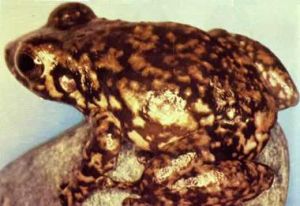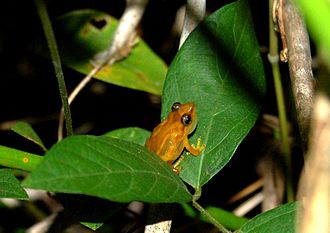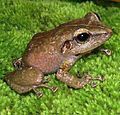AY Honors/Coquí/Answer Key/es
| Coquí | ||
|---|---|---|
| Unión Puertorriqueña Regional |
Destreza Año de introducción: |
[[File:|150px|alt=|]]
|
1
2
Ranas y sapos.
3
Las ranas se mencionan en la Biblia, más famosa como una de las 10 plagas contra los egipcios, que se encuentran en Éxodo capítulo 8. También se mencionan en Salmos 105:30 y Apocalipsis 16:13.
4
Son de sangre fría; la piel carece de cubierta alguna, son suaves y húmedas, a excepción de la Cecilia, que tiene pequeñas escamas en los pliegos externos del cuerpo; tienen una etapa larvaria acuática, necesitan el medio acuático para completar su ciclo vital; tienen dos pulmones y un corazón de tres cámaras.
5
Una ausencia de una membrana interdigital (lo que significa que no están adaptados para nadar); el falange terminal está en forma de T; tiene reproducción terrestre y desarrollo directo, lo que significa que no tienen una etapa de renacuajo, nacen de huevos como ranas pequeñas completamente formadas.
6
Se les llama coquí por el canto, sonido o llamado que emiten los machos durante la noche.
7
Diferentes coquíes hacen diferentes tipos de sonidos, tales como:
«Churi- ki – ki – ki», Coquí churí (Eleutherodactylus antillensis)
«Tic – tic – tic», Coquí de las hierbas (Eleutherodactylus brittoni)
«Clicks – clicks», Coquí de Eneida (Eleutherodactylus eneidae)
Pito fino y prolongado, Coquí pitito (Eleutherodactylus cochranae)
«Chip – chip» buy bajo, Coquí caoba, (Eleutherodactylus richmondi)
Como gotas de agua al caer, Coquí de Mona (Eleutherodactylus monensis)
«Tuit – tuit – tuit», Coquí dorado (Eleutherodactylus jasperi)
8
Este sonido tiene dos propósitos; el «CO» sirve para repeler a los machos y establecer un territorio, mientras que el «QUI» sirve para atraer a las hembras.
9
The genus is called Eleutherodactylus; there are several, several species that belong to this genus. Here are just a few examples:
Red-eyed coquí (Eleutherodactylus antillensis)
Dwarf coquí (Eleutherodactylus unicolor)
Spotted chirping frog (Eleutherodactylus guttilatus)
Lesser Antillean whistling frog (Eleutherodactylus johnstonei)
10
Colombia, Cuba, Guatemala, Dominican Republic, US Virgin Islands, UK Virgin Islands
11
11a
The web-footed coquí (Eleutherodactylus karlschmidti) (also known as Karl's robber frog).
11b
11c
Common coquí (Eleutherodactylus coqui)
Puerto Rican rock frog, locally known as the coquí guajón (Eleutherodactylus cooki)
Mountain coquí (also known as upland coquí, Puerto Rican robber frog), (Eleutherodactylus portoricensis)
Melodious coquí (Eleutherodactylus wightmanae)
11d
The Mona coquí (Eleutherodactylus monensis)
11e
The Dwarf coquí.
(at 0:14 seconds)
11f
The web-footed coquí (Eleutherodactylus karlschmidti) (also known as Karl's robber frog)
11g
12
The coquí is considered a plague on the islands of Hawaii. They were brought over by boats that were unloading ornamental plants from Puerto Rico.
13
Eneida's coquí (Eleutherodactylus eneidae), golden coquí (Eleutherodactylus jasperi), and the web-footed coquí (Eleutherodactylus karlschmidti)
14
It is our imperative to help protect and conserve the Puerto Rican coquí for the following reasons:
- Aesthetic: its habitats make up an incalculable and valuable resource and provide beauty to the island
- Economical: it brings tourism to the island
- Ethical: we are responsable for making the coquí endangered
- Ecological: it is an important predator to many nocturnal plagues
- Cultural: inside and outside of Puerto Rico, it is a symbol of Puerto Rican culture and its people
15
We can halt Deforestation, conserve the rainforest, develop educational environment programs, reduce pollution, in the air, water, and ground, and help fund research related to the coquí.
References














